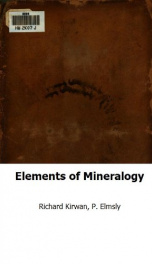elements of mineralogy

Purchase of this book includes free trial access to www.million-books.com where you can read more than a million books for free. This is an OCR edition with typos. Excerpt from book: Eftrth of Alum, or Argill. This earth forms the basis of common alum, and hence is by many called aluminous earth; it is also the true clayev part of common clay ; and hence, to distinguish it from the other heterogeneous parts, it is called argil!. It is seldom found nearly pure, and never absolutely so; the purest is extricated from alum by precipitation with the caustic volatile alkali; it is very white, smooth, and unctuous ; its specific gravity, when thoroughly dry, and free from fixed air, is 2,00; it is very diffusible, but not more soluble in water than pure magnesia. It is combinable with most acids, but (except in the act of precipitation) with great difficulty ; with the vitriolic it forms alum ; with the nitrous and muriatic it difficultly crystallizes. When heated it hardens and diminishes in bulk, but it is infusible in the strongest heat of our furnaces: the heat, however, given out by pure air appears to affect it, and dispose it to fusion, more than it does any of the before-mentioned earths. Microcosmic salt seems the flux best suited to argiil; it dissolves it with considerable effervescence. Borax is nearly as powerful, and produces less effervescence; but alkalis act nearly as on tlie preceding earths. Even in the moist way, caustic alkalis are capable of aclingon argiil. 'In its i.;n! stale of dryness it is capable of absorbing 2f times its weight of water without suffering any to drop out, and retains it, when exposedexposed to the open air, more obstinately than the foregoing earths: however, in a freezing cold, clay contracts more than any other earth, and, in contracting, squeezes out its water, and thus parts with more of it in that circumstance than other earths do; a fact of some importance in agriculture, as well as mineralog...
Info about the book
Author:
Series:
Unknown
ISBN:
1140730649
Rating:
4/5 (5)Your rating:
0/5
Languge:
English
Users who have this book
Users who want this book
What readers are saying
What do you think? Write your own comment on this book!
write a commentGenre
if you like elements of mineralogy try:
Do you want to exchange books? It’s EASY!
Get registered and find other users who want to give their favourite books to good hands!


